This Modern World: “Paul Shambroom: Picturing Power”
Visual arts writer Mason Riddle offers a nuanced analysis of photographer Paul Shambroom's body of work on exhibit at the Weisman devoted to the deconstruction of the contemporary seats of political power--from Peacekeeper missiles to city councils.
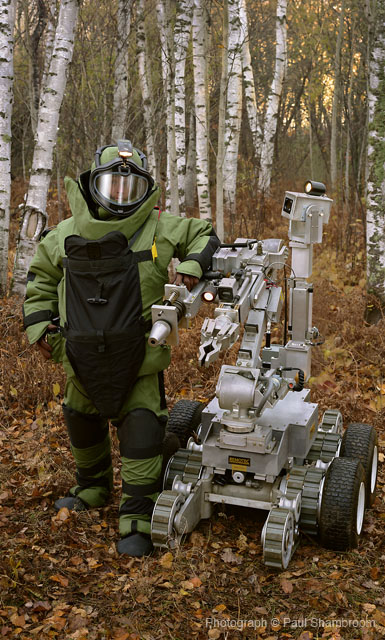
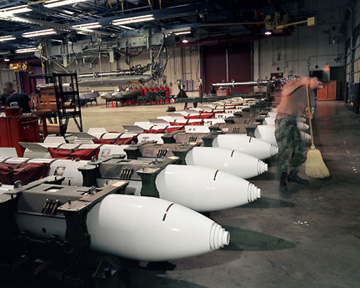
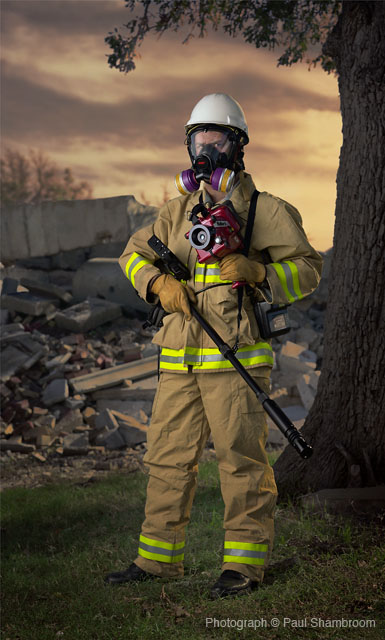
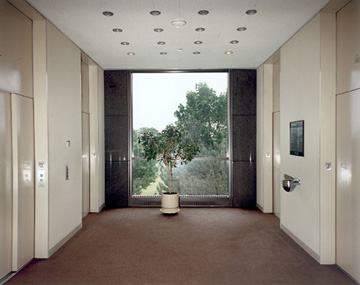
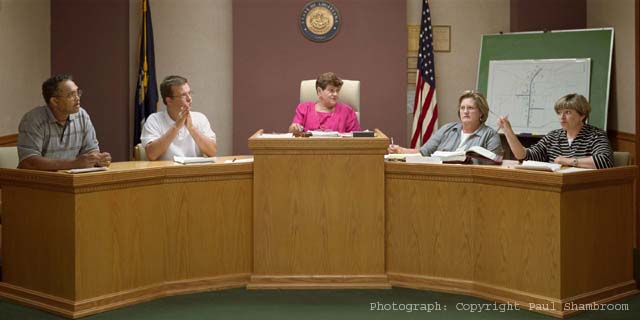
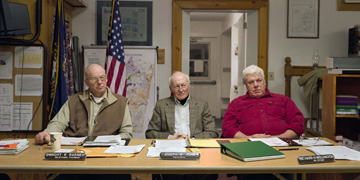
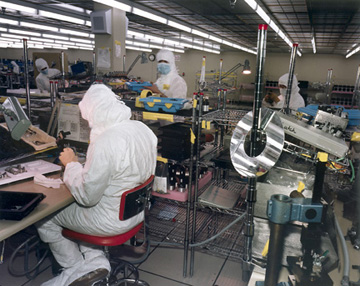
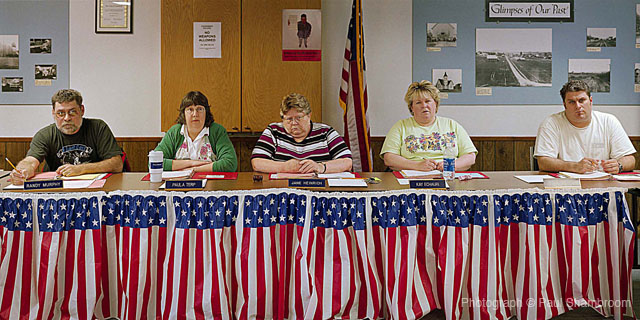

WITH THE FIFTH ANNIVERSARY OF THE WAR IN IRAQ NOW a historical marker, and more than 4,000 United States Servicemen and -women dead, Paul Shambrooms exhibition, Picturing Power, presents an even more sobering look at power, its sources and its repercussions. Picturing Power is an evocative show that features nearly fifty color photographs culled from five of Shambrooms series: Factories, Offices, Nuclear Weapons, Meetings, and Security. The images span a twenty-one year period (1986-2007), and are either C-prints or Inkjet prints on paper or canvas.
Shambrooms images are all rooted in his singular quest to photograph the diverse loci and manifestations of power. They depict what most of us will never see. Crisscrossing the country from corporate offices and military bases to town halls and terrorist training centers, Shambroom’s persuasive letters of introduction gained him access to often highly secure areasnuclear weapons sites, military bases, the Pentagonwhich would be all but impossible to duplicate in our post-September 11 world. The photographs include such subjects as a glowing, gritty iron foundry; a bland, corporate headquarters elevator bay; Peacekeeper missiles lined up like white eggs in a carton; an airless, small town council meeting; and, a post-September 11, first responder garbed in a brilliant yellow Hazmat suit and neon red boots. Meticulously composed, snap shots these are not. Rather, for each image, Shambrooms unblinking eye has constructed a calculated reality, one that is factual enough, but highly premeditated.
Shambrooms early training as a commercial photographer is evident in this work, yet not overbearing. The images project a level of visual perfection and, indeed, a level of artifice. Everything is in its place; these are anaesthetized environments. In the images from the Factories, Offices and Nuclear Weapons series, the human figure is largely incidental, if not completely absent. Instead, the tools (raw materials and manufacturing), activities (end-product and technology) and control (built environment, seats of authority and complex delivery systems), all inherent to power, are central. Whether it is a cavernous room at Hughes Aircraft Company in California, Honeywells residential controls room in Minnesota, a behemoth Trident submarine in dry dock in Washington, or the Joint Chiefs of Staff Conference Room at the Pentagon, the smell of power is pervasive. The synthesis of Shambrooms sophisticated use of light with his rigorous compositions causes the viewer to read the images like a grand and complicated cinematic set. The artifice is palpable, yet it doesn’t dissipate the quiet but insidious grip of power evinced by his work.
The Meetings series reveals power at a populist and fundamental level: local citizenry participating in small town meetings perpetuating the democratic process elemental power in and of itself. Here, mayors and council members sit side by side, as if in a banal Last Supper. Pigment Inkjet on canvas, these images project a slightly skewed reality of local government, composed in a way suggestive of passivity; in these images there are no arguments, no triumphs, and no desk pounding. Seen through Shambroom’s lens, no one speaks, smiles, or gestures. The participants look only at each other or stare unflinchingly into the camera lens. These are meeting rooms of stasis not activity. Democratic power is subjugated to the cultural signs of American flags and nameplates; it seems to be a sleeping giant.
In the most recent Security series, Shambroom takes the staged theatricality of the Meetings series one step further, into an uncanny hyper-reality. Figures dressed in vividly colored Hazmat suits or camouflage fatigues and breathing masks are encumbered by weapons, Geiger counters, and other anti-terrorist devices (including a personal robot). Ostensibly comical, it is soon clear that we have irrevocably moved to the dark side of self-preservation, no matter how brightly colored the wardrobe. Such is the age of Homeland Security.
Calling on the conventions of western portraiture, Shambroom has photographed the Security figures in the context of their training environment backgrounds – natural sylvan landscapes, tall grasses and autumn leaves, a stark mountainous desert, or Disaster City. Disconcertingly, these first-responders appear to hover in front of their backgrounds, as if they were action figures in front of two-dimensional 1940s film sets. Shambrooms Inkjet on canvas process magnifies this sense of visual dislocation. At their psychological edges, these images are drained of any documentary quality, flickering back and forth between being photographs or paintings, between reality and dream worlds. The imagery seems more rooted in video game culture than crisis prevention. However, notions of fantasy are dashed when the viewer locks onto the security figures steady gaze through the reflective transparent facemasks. This is not paint-ball combat; these are real people engaged in highly sophisticated training for the real horror.
Particularly chilling is SWAT team approaching house (Guam Police Department SWAT, Terror Town Playas Training Center, New Mexico), 2005, another pigmented Inkjet on canvas in the Security series. Here, seven armed individuals in black uniforms and riot helmets, with the word “POLICE” emblazoned in white across their backs, disembark a military vehicle and charge a flat-roofed, stucco building complex. The sky is vivid blue with wisps of clouds. The trees look to be in bud. The image has the stillness of a hermetically sealed box. This is Terror Town reality.
Shambrooms work reveals a porous boundary between veracity and constructed reality. The adage photographs never lie is a truth that, for many, has long since lost its validity. In fact, the artist states in one of the exhibition catalogue essays, people are learning to distrust images on an intellectual level, but I think on an emotional level you still immediately trust a photograph. I am sure we are losing that. Undoubtedly, these images convey ideas of power, or at least Shambrooms vision of power. But it is a reflection of resident power that extends only as far as portrayals of those sites to which he has been given access.
Arguably, these images do not, in fact, depict power but only its trappings – sites where power flourishes, where the materials and the constructions of power are generated and disseminated. Power is vested in human discourse and action; it exists primarily in its accrual and administration. In this sense, Shambrooms Meetings photographs may be the most incisive look at power, although the images seem mundane when compared to those depicting nuclear warheads or the manufacture of the space shuttle Endeavor. Even a person dressed in a yellow Hazmat suit and red boots appears foreign, so fantastical as to negate received notions of real, human-held power.
Shambroom crafts exquisitely conceived images whose subject matter intellectually shape-shifts from the authoritarian stance of power in the abstract and warheads at rest, to the absurdity of the real world manifestations of power: a figure covered head-to-toe in an insulated puffy green suit and headgear, leaning on a stainless steel robot in the birch woods of northern Minnesota. The beauty or absurdity of the images undercuts the veracity of its subject matter and risks enervating the image of any tangible seriousness. It is with this dichotomy in Shambrooms images that the viewer must come to terms. The ambiguities and contradictions are inescapable. In the end, Shambroom’s manifold portrayals of power allow us to project beyond the roles of these specific sites and figures, to the presumed activity of power and, more critically, to the psychology behind its wielding.
About the writer: Mason Riddle is a critic and writer on the arts, architecture, and design. She is the current president of the Visual Arts Critics Union of Minnesota.
What: Paul Shambroom: Picturing Power
Where: Frederick R. Weisman Art Museum, Minneapolis, MN
When: The exhibition runs through April 20